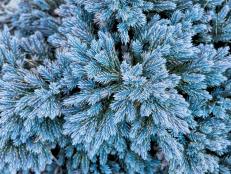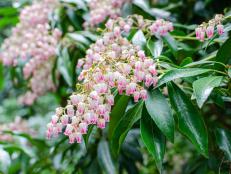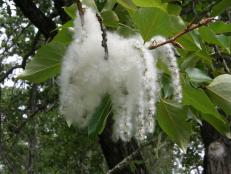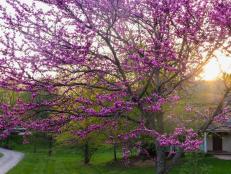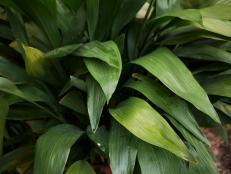Help for Unhealthy Pine Trees
Find remedies for common pine tree problems to keep them looking beautiful for years to come.

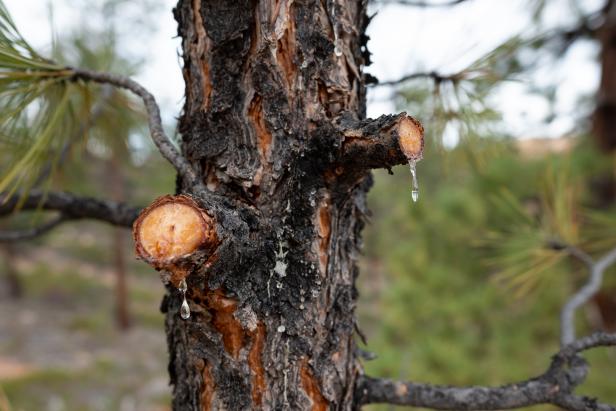
Kyle Krakow
Remove the lower branches of a pine tree that are dead, dying or damaged. This helps reinvigorate the tree. Avoid cutting the limb flush with the trunk so the wound can heal properly.
Brown needles, dead branches and oozing sap — if you know what to look for, you can often read the signals pine trees put out when they need help. Sadly, sometimes pine trees can be too sick, stressed or damaged to save. The Southern pine beetle, for example, is a highly destructive pest that affects pines in the Southern U.S., and often the only “cure” is to remove the infested trees.
But there are easier, less radical solutions to other problems. Check out this list to identify your pine tree’s symptoms and find suggested treatments. Whenever you’re not sure what to do, check with your cooperative extension service for help.
Problem: Die-Back of Upper Branches
Is the ground at the base of your tree covered over with concrete, pavers, asphalt or other heavy material, or is there a lot of vehicle or foot traffic around the tree? If so, the soil may be compacted, and the tree may not be getting enough oxygen, water or physical space for its roots.
Solution:
If the soil is compacted from heavy traffic or use, add a barrier around the tree or create a new path away from the base of the tree.
If there’s a permanent, hard material covering over the soil around the base, use an auger to drill lots of holes in exposed soil nearby. If you hit a root, reverse the drill and try somewhere else. Drill dozens of holes, keeping them about 12 inches apart.
Next, fill the holes with a product that contains organic matter and mycorrhizal fungi. These beneficial fungi help roots absorb water and nutrients. They’ll also help the tree resist some diseases, tolerate extreme soil temperatures and compete with turf grasses, among other things. In return, the roots feed the fungi with sugars. Be sure to water the tree deeply and thoroughly when you add the fungi to the holes. You want the water to penetrate to the subsoil—but apply it slowly enough so that it doesn't run off.
In time, this symbiotic partnership between the fungi and the roots will reduce the tree’s need for fertilizer and may help it grow stronger and live longer. But getting your tree healthy again will take time, so don’t expect to see immediate results.
Problem: Dead, Diseased and Damaged Branches
Solution:
Dead and dying wood is a magnet for diseases and pests, so it has to go. Prune as needed, cutting back to healthy branches. Use rubbing alcohol between cuts to disinfect your tools. Try to keep the tree’s natural shape, and avoid cutting the branches flush to the trunk, which may damage the bark. Instead, keep the branch collar—the swollen area around the base of the branch—by cutting outside the collar at a 45- to 60-degree angle. Leaving the branch collar intact will help prevent decay.
Unless you’re trying to control insects that carry disease, it’s not necessary to paint the pruning cut with tree paint or wound dressing. Research has shown that most wound dressings won’t prevent decay, and some actually feed undesirable microorganisms.
Problem: Lots of Oozing Sap
Sap carries water and nutrients from the roots to all parts of a tree. Sometimes healthy plants drip small amounts of sap, so as long as the bark looks healthy, your tree is probably fine.
Excessive sap loss is another story. This can result from the kind of injury that occurs when branches are broken in a storm or when lawn equipment hits a tree. Sap may also flow heavily because of insect damage or fungal and bacterial cankers.
Solution:
If you see sap dripping from multiple holes that appear bored in the tree, suspect insects (although some woodpeckers also make holes and feed on sap). Check with your county extension service office if you need help identifying the problem and finding the right treatment.
Cankers are dead spots on your trees, usually caused by fungi that grow under the bark. These dead places may be sunken, cracked, swollen or discolored. Sometimes resin leaks from a canker and forms a white patch on the bark. Cankers can be a gateway for bugs, bacteria and other fungi to enter the living tissue of the tree, and if the tree is already weak or stressed, they can even kill it.
Unfortunately, there aren't any chemicals that will control canker disease once the fungi take hold. But you can control it if you catch it early by pruning out affected branches.
When dealing with cankers — or most other pine tree problems — the best approach is a good defense. Prevent cankers from starting by taking care of your trees: space them properly when you plant them; plant them in soil with good drainage; fertilize when needed; control weeds; and water deeply and thoroughly, especially when new trees are established and/or during periods of drought.






